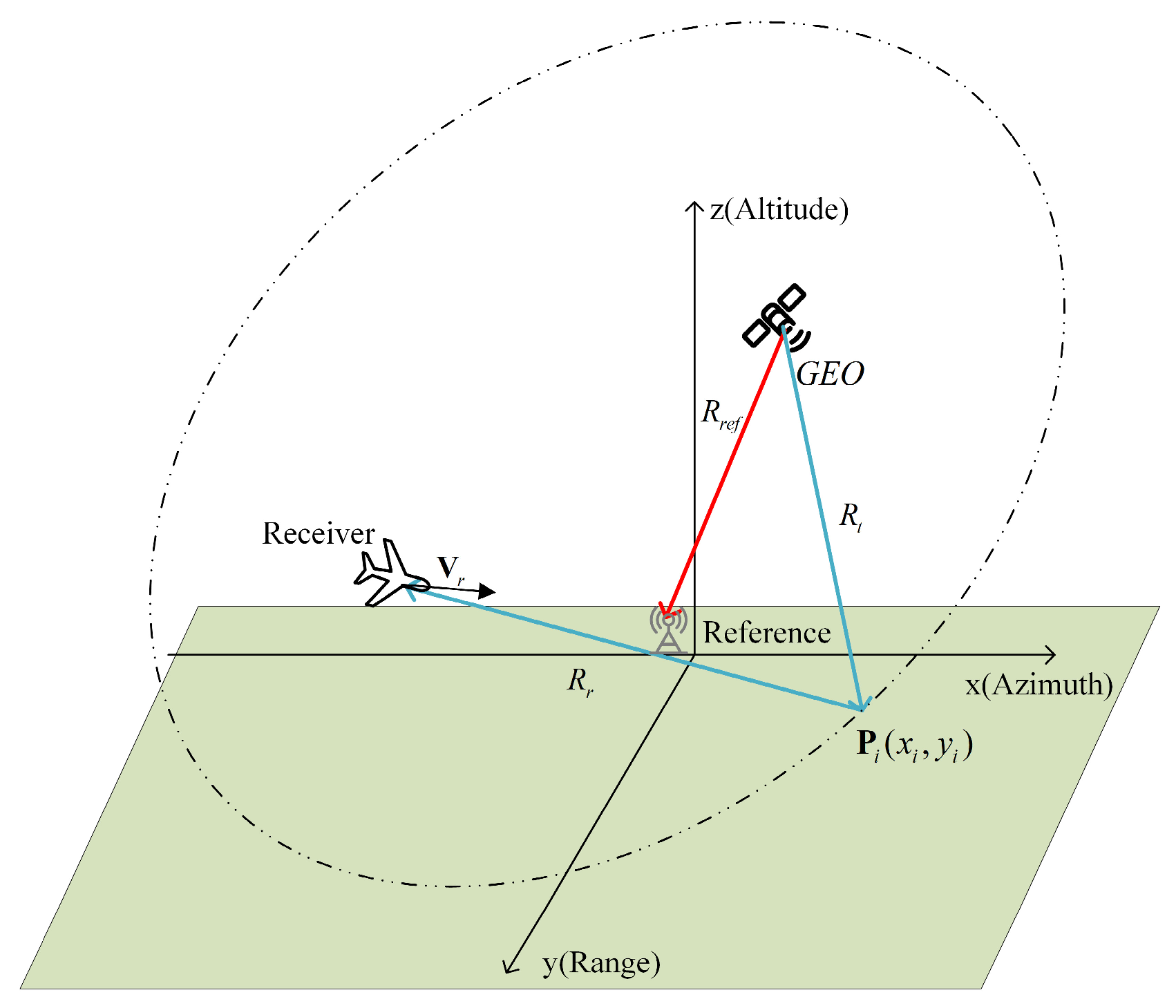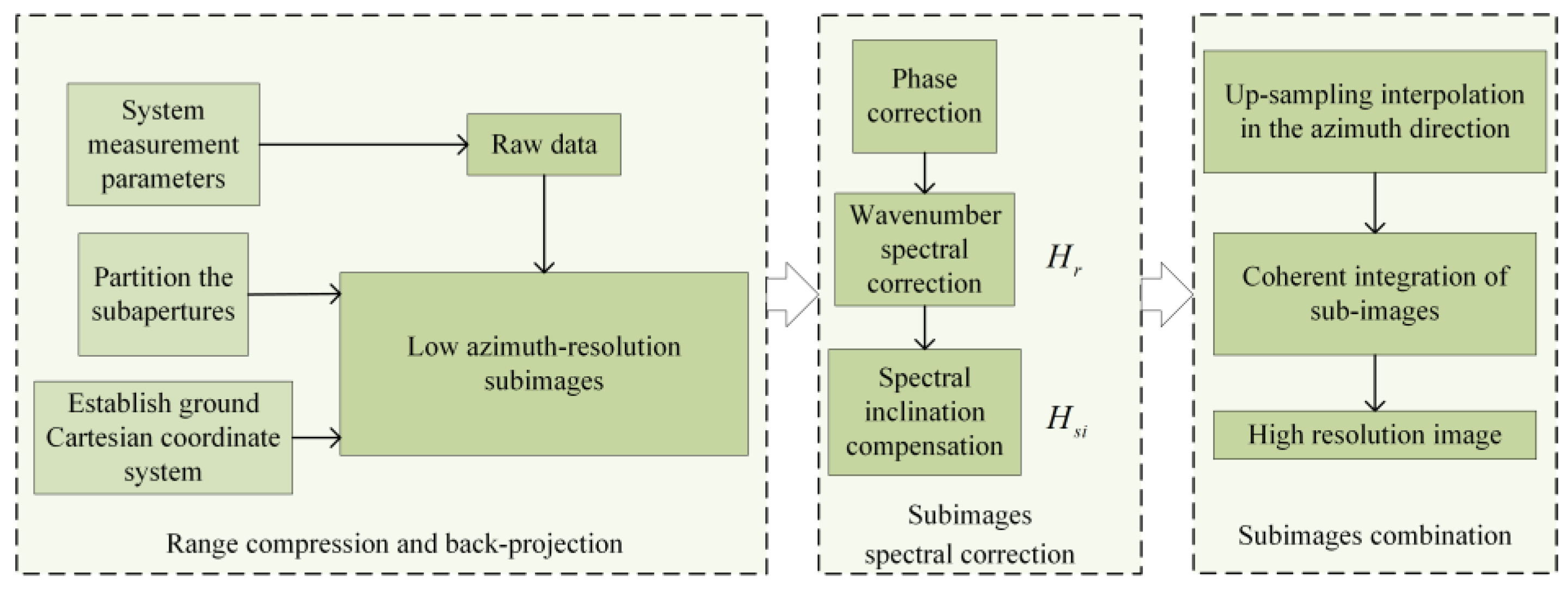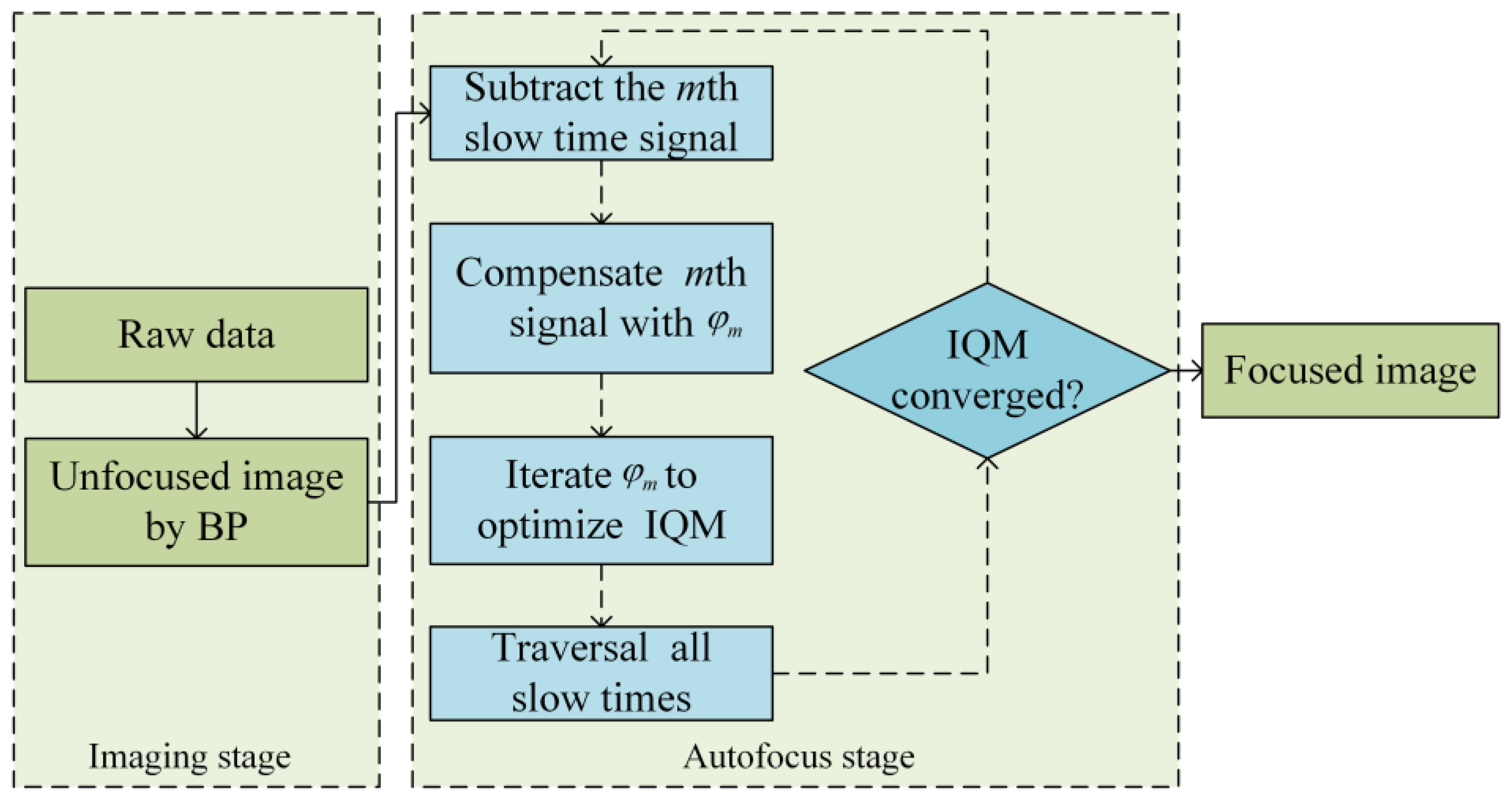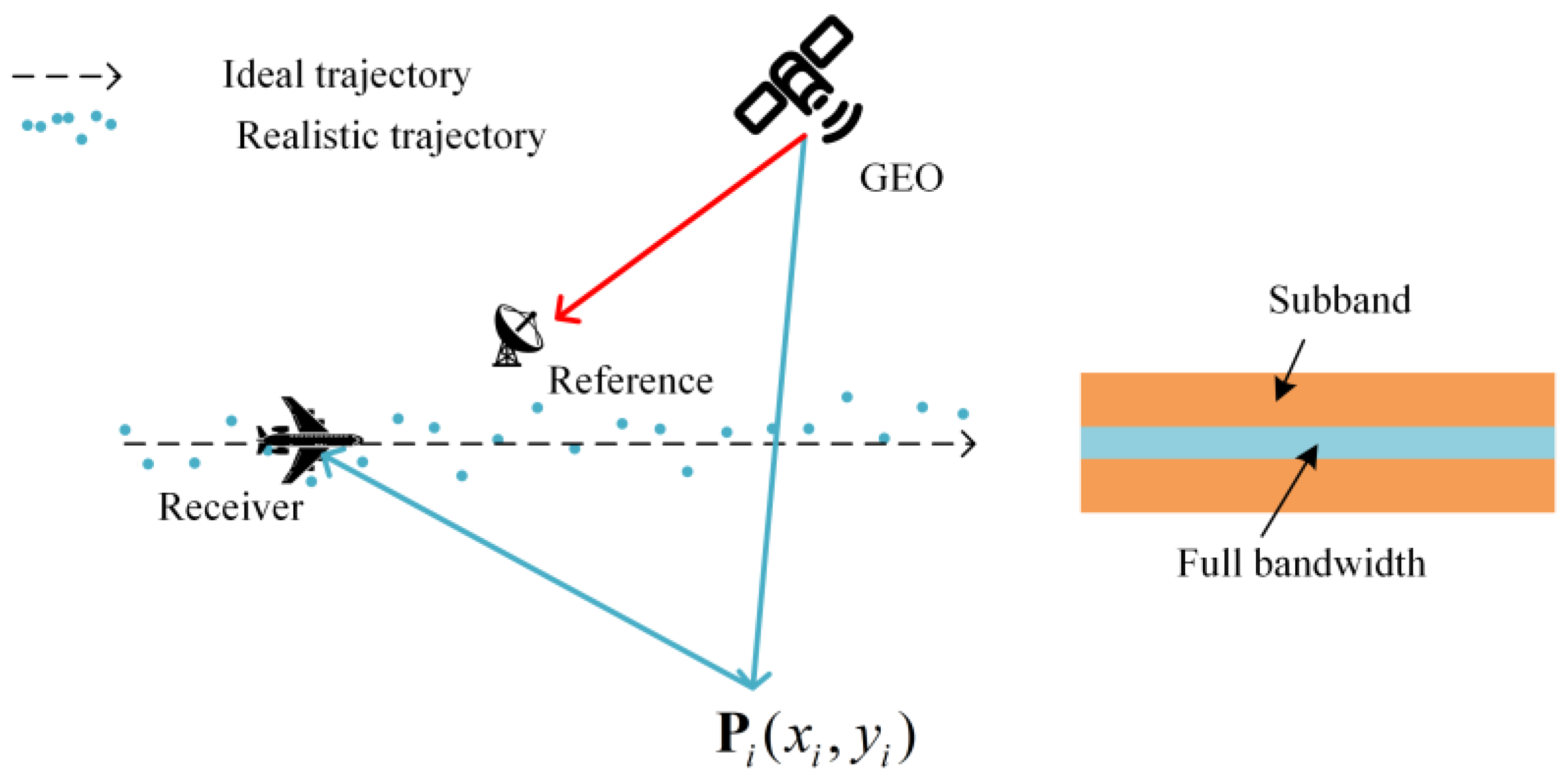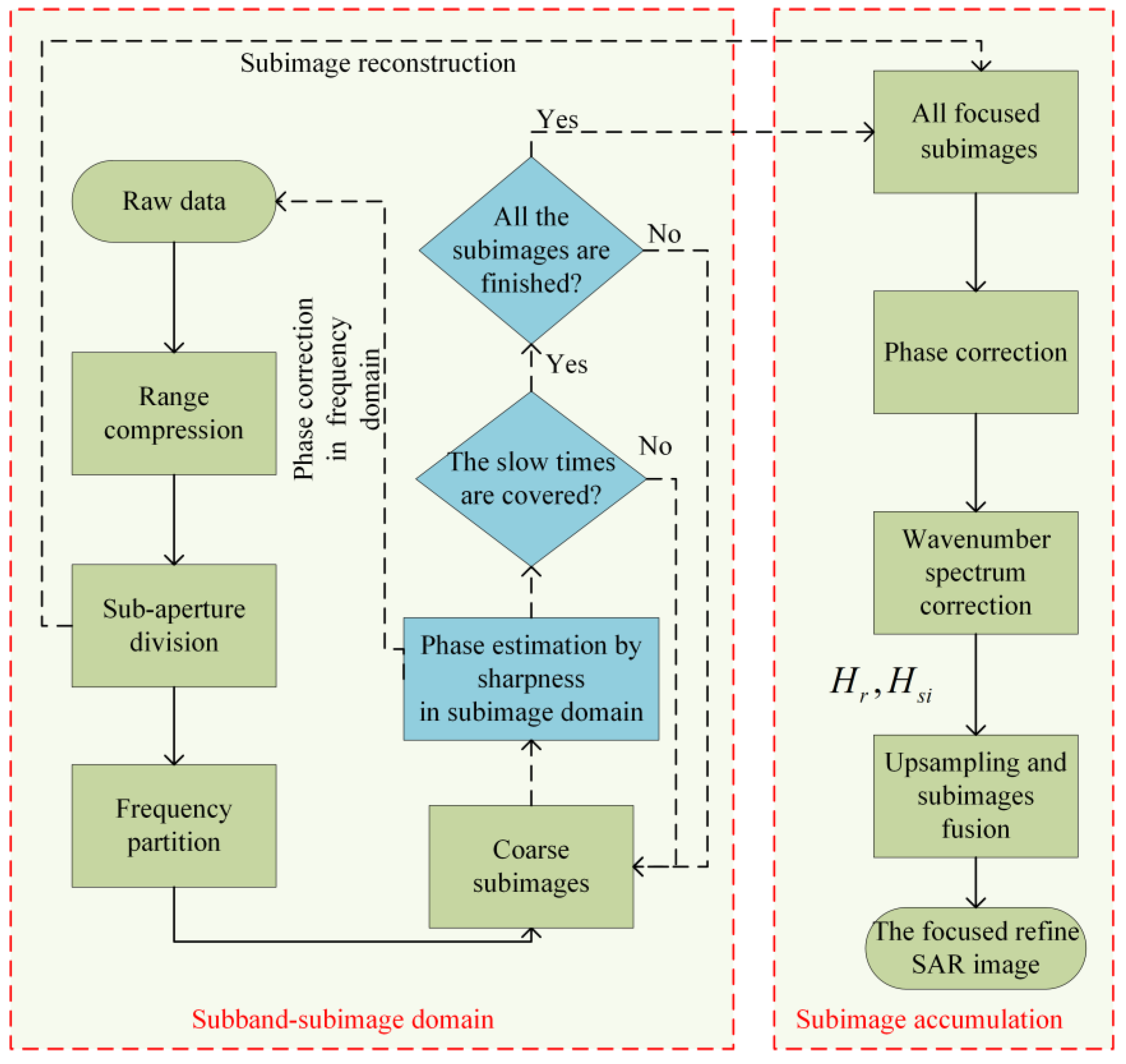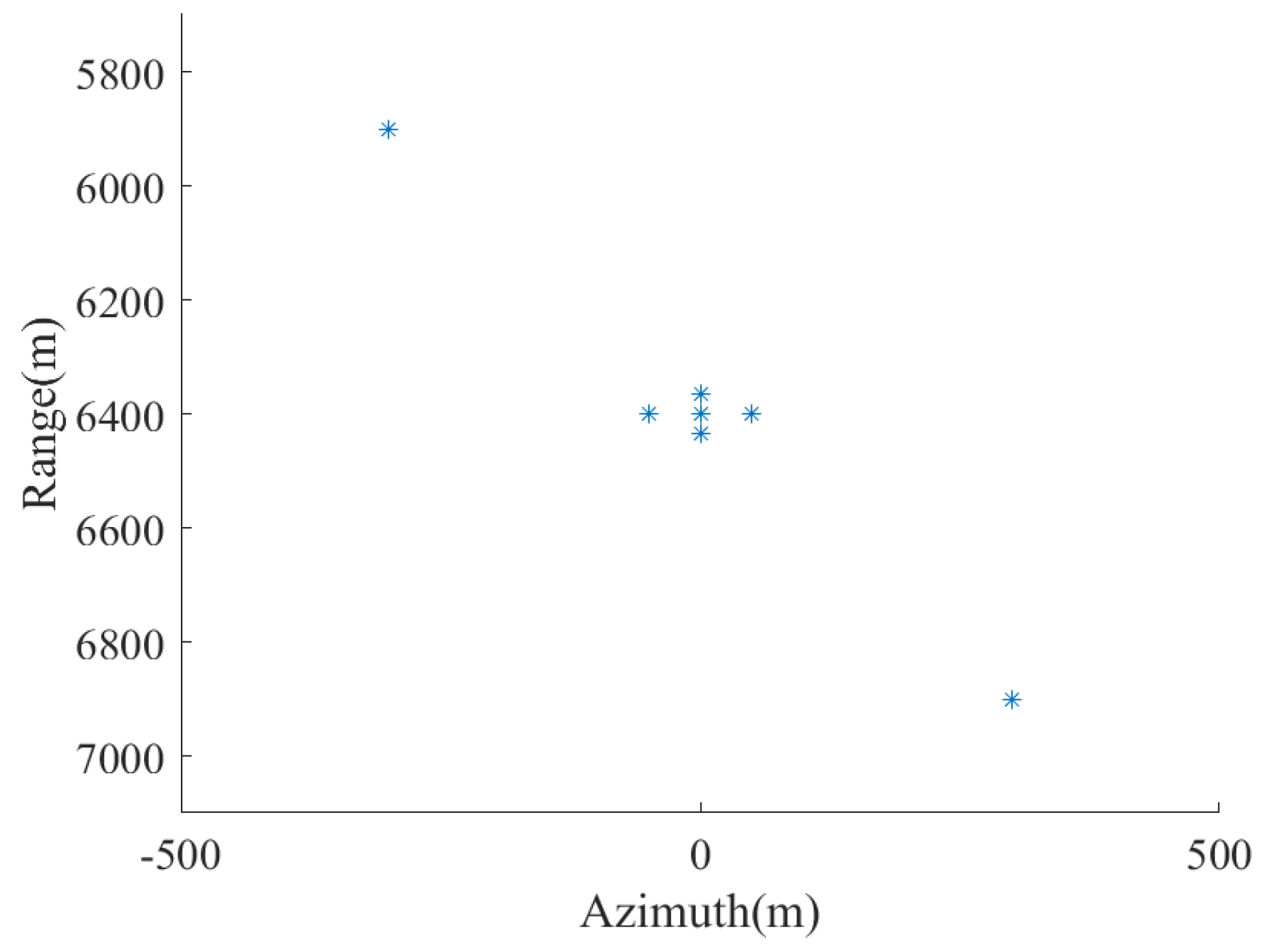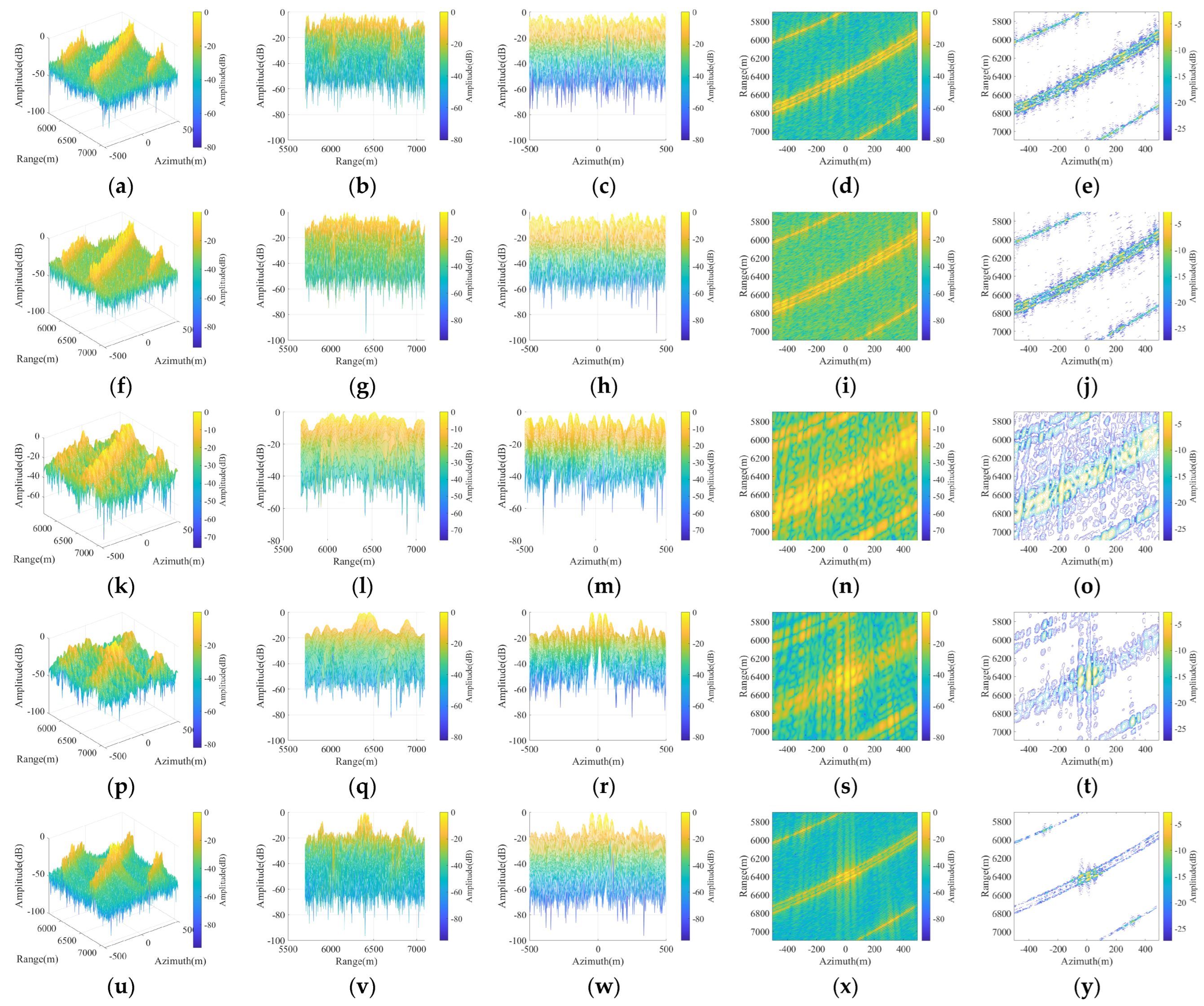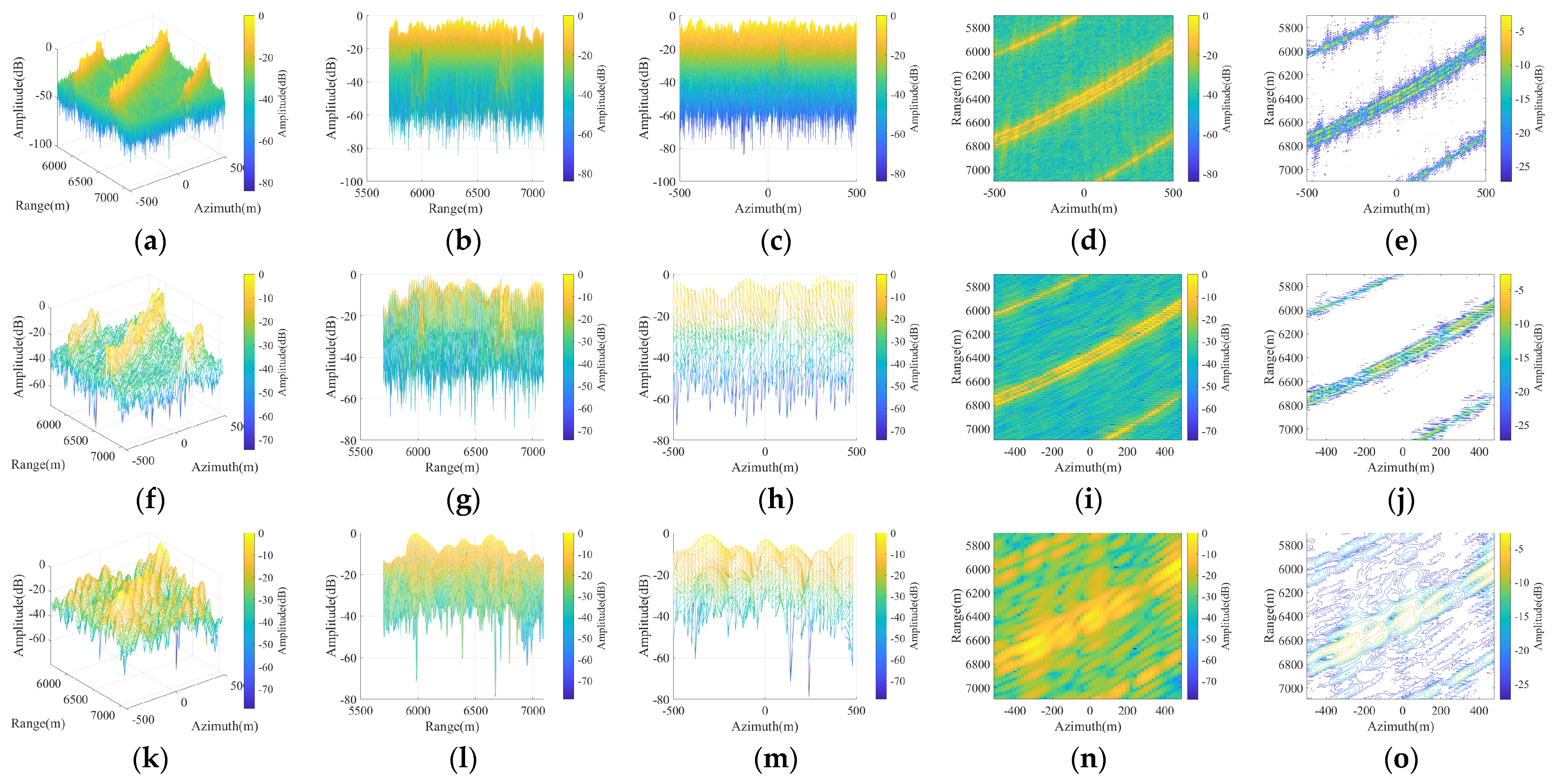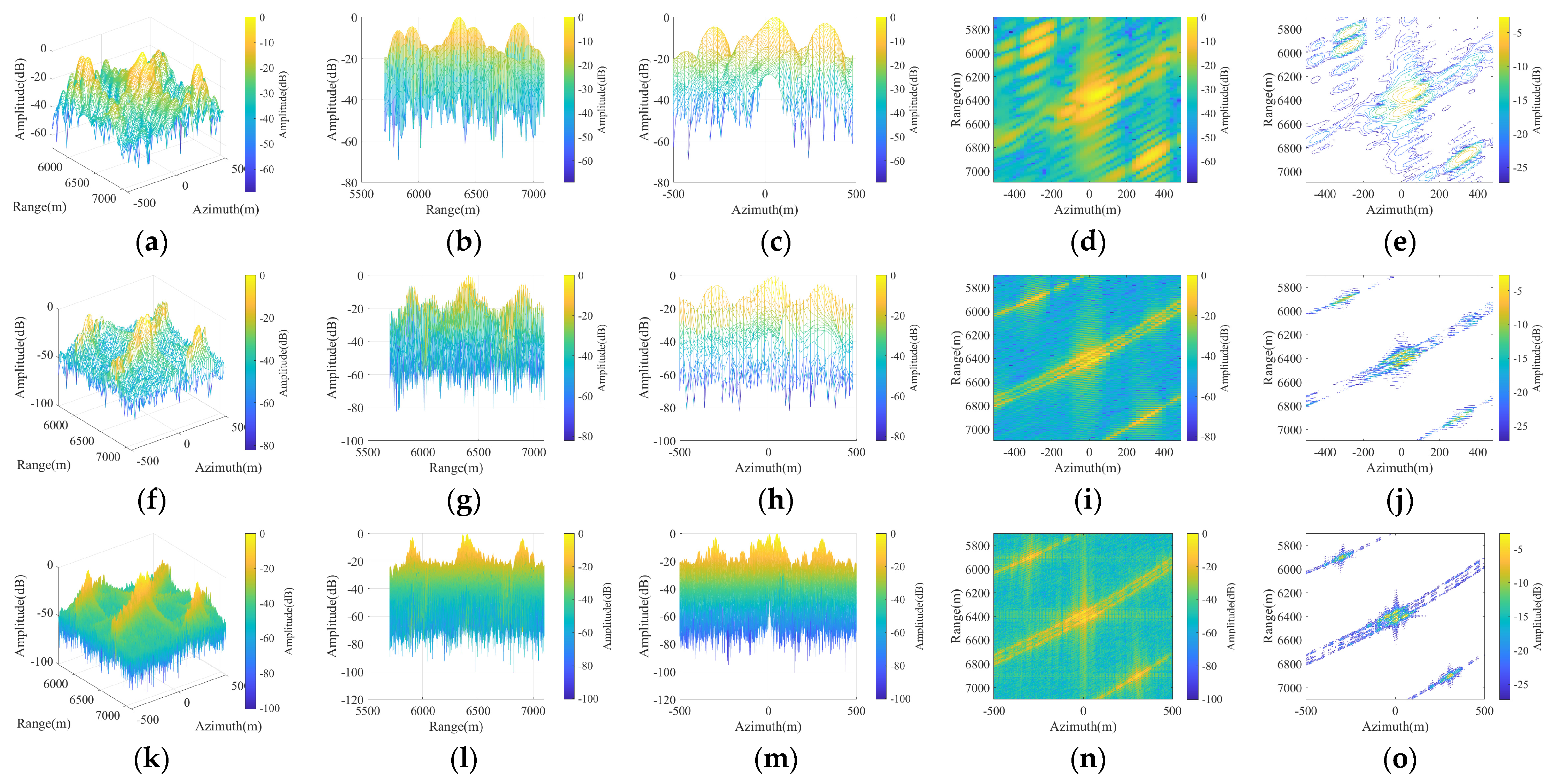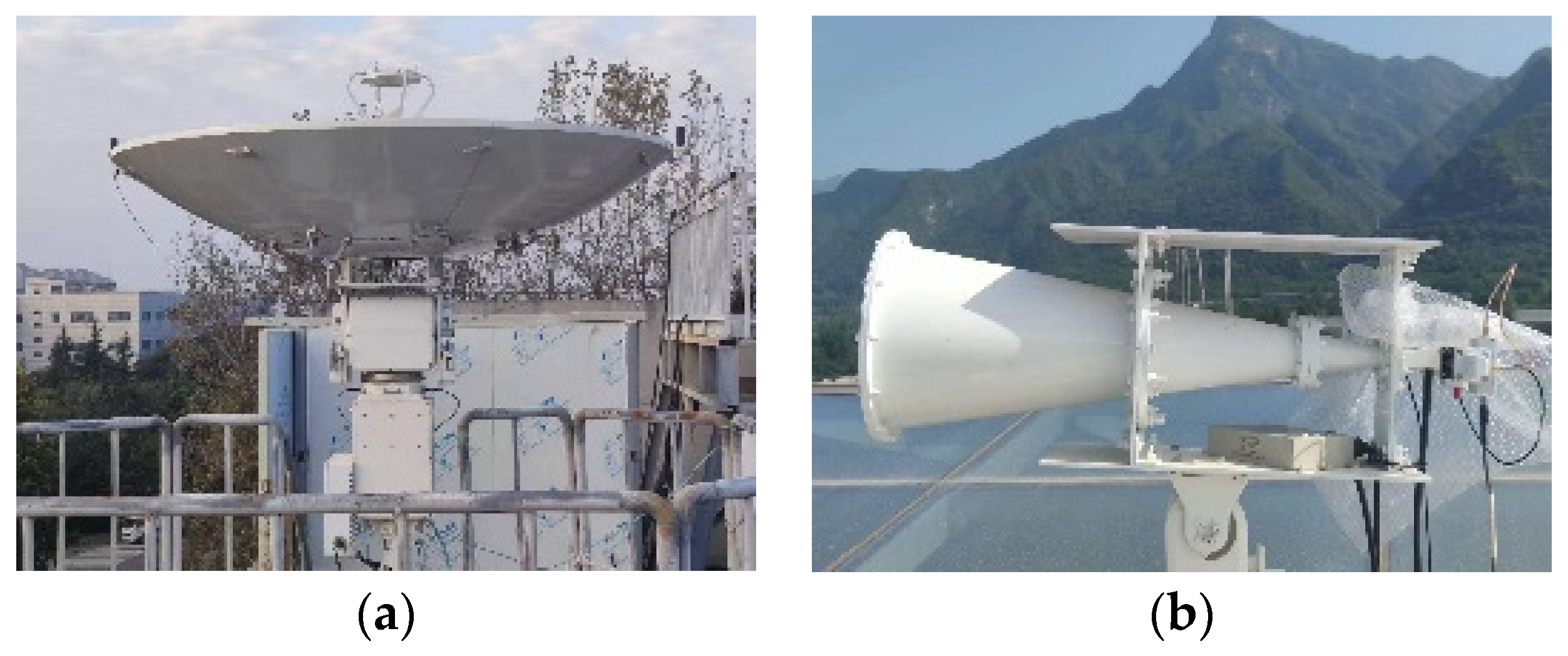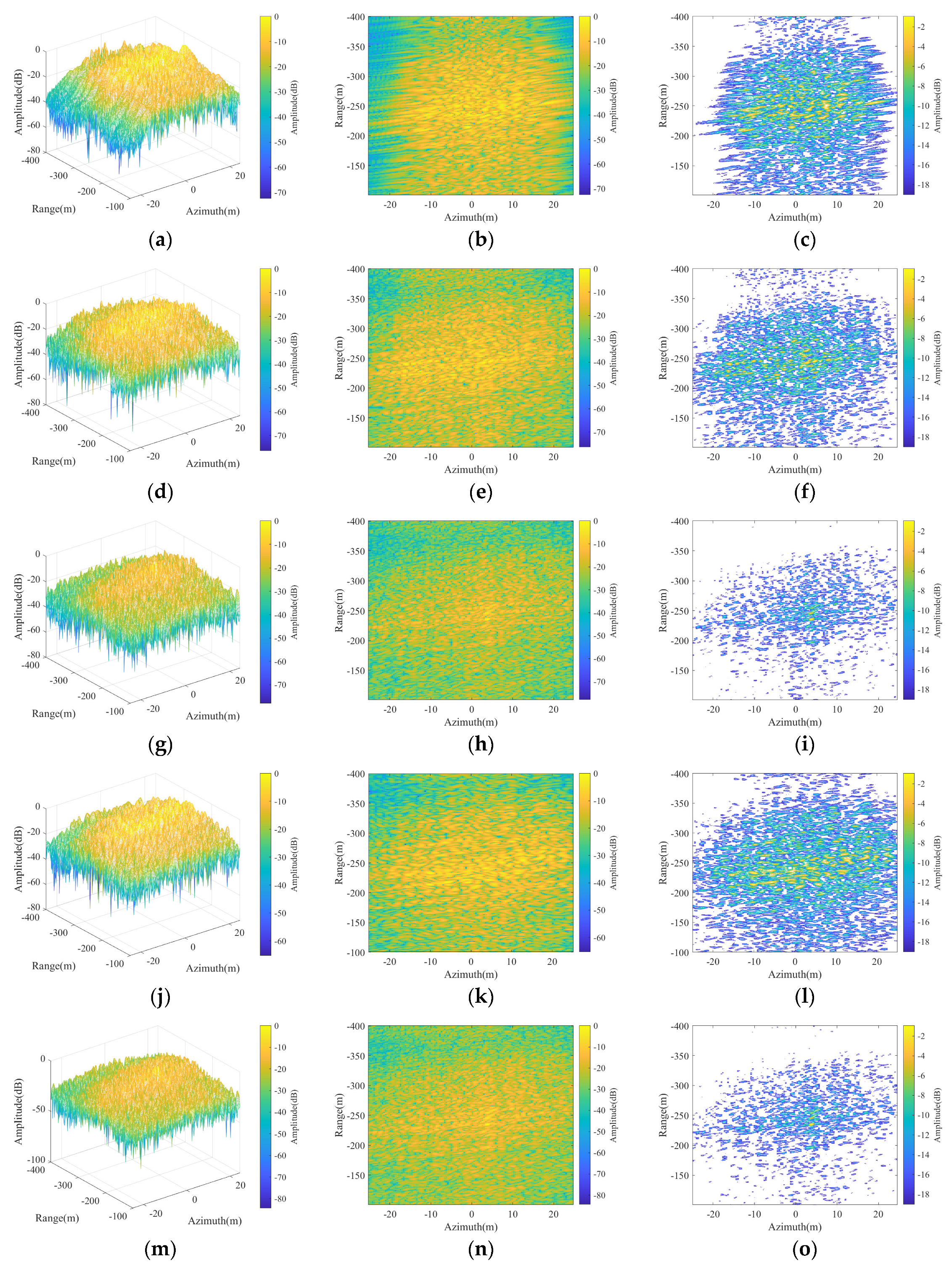The proposed MSAFBP and ERAFBP algorithms were validated through simulation and real-environment experiments, with their performance and efficiency quantitatively analyzed in this section. MATLAB (version R2021b) is used for all simulation experiments and data processing.
3.1. Simulation Experiments
The configuration of scattering centers in the simulation experiments, based on the coordinate system established in
Figure 1, is illustrated in
Figure 9.
Based on the random characteristics of the opportunistic illuminator signal, generated pseudo-random signals are used to simulate the reference signal and echo signal. The operational parameters of selected satellites and corresponding signals are tabulated in
Table 1. The sampling rate of the signal remains consistent with the signal bandwidth.
The receiving antenna traverses along an east-west trajectory with its beam direction oriented toward the southern target imaging area. The effective synthetic aperture length measures approximately 6 m. The acquisition parameters comprise 200 slow-time samples and 2000 fast-time sampling points, corresponding to a signal duration of 0.1ms. The number of sub-apertures is configured as four to optimize the trade-off between computational efficiency and the rendering quality of sub-images.
A rigorous quantitative framework was implemented to assess the performance and computational efficiency of the proposed algorithms. Imaging contrast serves as a key metric for evaluating reconstruction quality and autofocusing precision, while algorithmic efficiency is quantified through processing time measurements.
The imaging results of the original BP algorithm are depicted in
Figure 10a–e. Except for the contour plots in the rightmost column, which employed a −30 dB threshold to enhance image clarity, no additional thresholding or artificial noise was introduced to the remaining images to preserve the integrity of data visualization. Unless otherwise specified, all the subsequent experimental imaging results will adhere to this standardized protocol.
For more precise quantitative analysis of simulation results,
Table 2 provides key measured parameters: envelope contrast and computation time. All simulation-derived parameters were statistically averaged across 16 independent trials to ensure robust confidence intervals, which is also used for subsequent statistics.
As observed in
Figure 10f–j, the azimuth resolution undergoes degradation due to the partitioning of the effective aperture, which arises from the reduction in the length of the effective synthetic aperture of the sub-aperture.
Figure 10k–o demonstrate that the EGCBP reconstruction achieves imaging fidelity comparable to the theoretical limit of conventional BP, which corresponds to the contrast in
Table 2. Scattering centers within the central region validate the preserved resolving capability of the EGCBP framework, whereas peripheral scatterers illustrate its robust imaging performance in off-center areas. Furthermore, as evidenced by the computation time in
Table 2, the sub-aperture division strategy significantly enhances processing efficiency.
Furthermore, simulation experiments are conducted to verify the performance and efficiency of MSAFBP. During the experiments, the original signal was filtered to generate a sub-band signal with a bandwidth of 1/8 of the original, which was then used to implement autofocus processing. The performance validation of MSAFBP is demonstrated in
Figure 11 where systematic errors are configured as random motion deviations. And the measured parameters are detailed in
Table 3.
The errors critically disrupt phase continuity and corrupt the envelope structure of radar echoes. The original imaging results in
Figure 11a–e and the AFBP outcomes in
Figure 11f–j reveal both the pronounced impact of such disturbances and the severe performance degradation inherent to conventional AFBP algorithms. As evidenced by the contrast metrics in
Table 3, the sharpness-based AFBP achieves only marginal contrast enhancement. Consequently, the results in
Figure 11f–j exhibit poorly resolved scattering centers, which is attributed to residual defocusing artifacts and significant energy leakage.
In contrast to the sub-band imageries in
Figure 11k–o,p–t, achieved by the autofocus-processed results based on frequency partitioning strategies, they exhibit effective mitigation of frequency-dependent errors and enhanced focusing precision. The sharpness-based autofocusing process increased the image contrast from 1.5276 to 1.8775 in the sub-band images (Sub-band image (sharpness) in
Table 3) compared to their defocused counterparts (Sub-band image (unfocused) in
Table 3) without autofocusing. The final MSAFBP reconstruction in
Figure 11u–y demonstrates superior refocusing through phase error estimation derived from sub-band data, yielding imaging fidelity that closely approximates the theoretical benchmarks of the original BP results in
Figure 10. This is consistent with the improvement in contrast of the reconstructed BP images in
Table 3, where the metric increased from 2.3169 before autofocusing (BP (unfocused) in
Table 3) to 3.1142 post-processing (BP (reconstructed) in
Table 3). Furthermore, the total processing time of the proposed MSAFBP is merely 24.8% of that required by conventional AFBP algorithms, as shown in
Table 3, highlighting its substantial efficiency gains.
It is critical to note that variations in imaging settings caused significant disparities in contrast metrics across different types of images; thus, contrast comparisons are meaningful only between images within the same category. The rationale equally applies to subsequent analyses of sub-images and sub-band sub-images.
Expanding the analysis, simulation experiments of the ERAFBP algorithm were conducted.
Figure 12 presents defocused images for comparative analysis. The defocused image obtained from conventional BP (shown in
Figure 11a–e is not redundantly displayed here. Compared to the ideal imaging results in
Figure 10, the defocused images in
Figure 12a–j exhibit severe energy leakage and poorly resolved scattering centers, a degradation further corroborated by the lower contrast metrics of BP (unfocused), EGCBP (unfocused), and Sub-image (unfocused) in
Table 4.
Figure 12k–o presents the sub-band sub-images obtained through sub-aperture division followed by frequency partitioning. These sub-band sub-images also exhibit ineffective energy accumulation, particularly under severe system errors, resulting in unresolved scattering centers and degraded imaging fidelity.
To address this, the autofocus strategy from MSAFBP was employed during the sub-image processing stage for phase error estimation. The proposed method generates the refocused sub-band sub-images shown in
Figure 13a–e. Compared to their defocused counterparts in
Figure 12k–o, the MSAFBP-processed images demonstrate a contrast improvement from 1.4235 to 1.7412, as validated by the metrics in
Table 4. Similarly, the reconstructed sub-images in
Figure 13f–j exhibit enhanced focusing performance, aligning with the quantitative contrast metrics (from 1.6958 to 1.9325) in
Table 4. Ultimately, through the multi-image fusion, the proposed ERAFBP achieves the final imaging results shown in
Figure 13k–o, which exhibit significant focusing enhancement compared to those in
Figure 12a–e. The proposed ERAFBP achieves a contrast improvement from 2.3221 to 3.0215 in
Table 4, outperforming the 2.4120 value of conventional AFBP. As evidenced, scattering centers exhibit enhanced energy concentration in the ERAFBP output (refer to the 3.3621 of imaging results achieved by BP in
Figure 10), demonstrating closer alignment with theoretical benchmarks. The minor degradation, in contrast, arises from slight residual phase errors that persist in the autofocus procedure and interpolation errors introduced during the sub-image processing stage.
Quantitative analysis of imaging contrast in
Table 4 reveals that ERAFBP further enhances computational efficiency over MSAFBP (from 4.9890 in
Table 3 to 2.0254 in
Table 4) while preserving its robust autofocusing performance. Under the simulated parameter configuration, ERAFBP achieves a processing time of merely 10.1% of that required by the conventional AFBP algorithm.
Notably, while the proposed autofocus strategy necessitates multi-stage processing and secondary back-projection, computation time statistics in
Table 4 demonstrate that the computational overhead of back-projection remains substantially lower than that of autofocus optimization. Consequently, the efficiency gains in the autofocus phase fully compensate for the added projection burden, preserving the overall computational advantage over conventional methods.
In conclusion, compared to motion-error-corrupted BP imagery, conventional AFBP demonstrates limited quality enhancement, whereas the developed MSAFBP framework demonstrates robust capability in handling autofocus processing under challenging systematic error conditions while simultaneously improving computational efficiency. By synergistically integrating MSAFBP with the proposed EGCBP, the ERAFBP algorithm establishes an optimized rapid autofocus architecture that significantly enhances the operational efficiency of autofocus methodologies.
3.2. Experiments in Real Environment
For real-environment validation, a customized data reception and processing system was designed to acquire and process experimental data. The receiving system operates in the Ku band and is equipped with a multi-channel high-speed sampling system, which is shared by the reference antenna and echo antenna. The received signal will be down converted to baseband and sampled for further processing. A circularly polarized high-gain parabolic antenna (
Figure 14a) was deployed to acquire reference signals from a GEO satellite positioned at 92.2°E. This satellite achieves stable regional coverage by retransmitting broadcast television signals. The signal modulation format is a phase-modulated signal, encompassing multiple channels. The horn antenna configuration shown in
Figure 14b generated effective aperture synthesis for achieving high azimuthal resolution through controlled platform displacement. Due to the small platform of the echo antenna, it cannot be equipped with a high-precision positioning device during the movement. The reference antenna, on the contrary, has a high-precision positioning system and remains stationary during data acquisition.
The experimental setup aligns with the coordinate system defined in
Figure 1. The echo antenna traverses an east-west trajectory with its beam oriented northward, achieving an effective synthetic aperture length of approximately 10 m. The operating bandwidth of the system is 100 MHz, which is slightly larger than the effective bandwidth of the signal. A small vehicle containing potential strong scattering points was present within the scene, which can be used to validate the system’s imaging capabilities.
Figure 15 presents the imaging results of the original BP algorithm and those proposed algorithms in this study, including the intermediate steps. Due to the strong noise effect in the real environment, the threshold of the contour map was adjusted to −20 dB. The imaging results achieved by BP without AF processing, as shown in
Figure 15a–c, are suboptimal for unpredictable deviations in the motion trajectory. The MSAFBP autofocusing strategy proposed in this paper demonstrates superior performance over the conventional AFBP algorithm in
Figure 15d–f, producing clearer and better-focused images that correspond to real-environment structures, as shown in
Figure 15g–i. As evidenced by the quantitative parameter measurements presented in
Table 5, MSAFBP used less time (15.396541 s) to increase the contrast to 1.3035. In contrast, AFBP took 64.038574 s but only increased the contrast from 1.2211 (the original BP result) to 1.2603. Thus, MSAFBP exhibits enhanced focusing capability while maintaining higher computational efficiency. Similarly, the imaging results of the proposed ERAFBP in
Figure 15m–o demonstrate improved focusing performance compared to results of EGCBP in
Figure 15j–l.
Through implementation of an accelerated sub-aperture division strategy, the EGCBP algorithm achieves significant operational speed improvements while maintaining high autofocus performance, a conclusion substantiated by the measurement parameters in
Table 5. It should be noted that, consistent with the conclusions of the simulation experiments, ERAFBP has inferior focusing performance compared to MSAFBP (1.2915 vs. 1.3035) due to sub-image interpolation, which is an inherent issue in sub-image fusion. However, it has higher efficiency, achieving a shorter computation time of 3.519445 s. Therefore, in practical scenarios, it is crucial to select and apply algorithms based on actual needs to achieve a balance between efficiency and performance.
These experimental results from practical environmental testing validate both the performance efficacy and operational efficiency of our proposed algorithms, showing consistent alignment with findings from simulation experiments.
